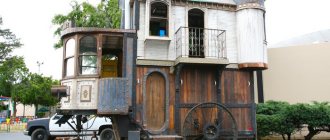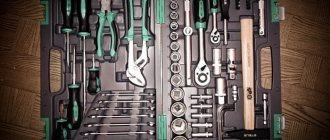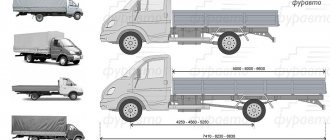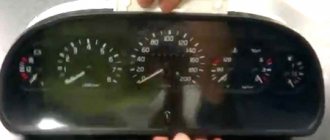Camper GAZ-27057
Camper GAZ-27057
Camper GAZ-27057
from Germany, together with the GAZ Group, made an attempt to fit a one-room residential compartment into the body dimensions of a standard GAZ-27057 van. So gas dealers now have a car-house in their price list.
The Gazelle looks like a Gazelle, only with a very high roof. According to the passport, it can accommodate seven people, but there are only four sleeping places. You can add a fifth passenger if it is a preschool child. The front porch of the “white house”, driven by an electric motor, is hidden under the bottom during movement.
The first floor has its own oval office: a table and four chairs with seat belts. In order not to push your neighbors with your elbows, the chairs can be moved apart. In the stern there is a small kitchen table with a gas stove and a refrigerator, next to a toilet with a washbasin. The latter are separated from the kitchen by a cheerful curtain. Simple manipulations turn the toilet into a shower. Obviously, with such an abundance of furniture in the room, travelers should be slim and short.
Features of mobile homes
A mobile home has undeniable advantages - comfort, coziness and mobility. Moscow is a noisy city that you sometimes want to leave. Trailer owners do not have to look for a place to stay overnight, and travel becomes very economical. If you haven’t had the opportunity to use this original housing before, you should first familiarize yourself with their classification.
Types of motorhomes and their classification
When choosing the type of future mobile housing, you can be guided by its division according to:
- in appearance - there are trailers, vans, or mobile homes combined with a car;
- class – there are three classes of comfort for motorhomes;
- trailer type - there are trailer trailers, hybrid trailers and fifth-wheel trailers.
If everything is clear with the trailer type of mobile home, then the difference between a van and a combined motorhome is not immediately visible. In the first option, the living space is located in the car van and is separated from the driver's seat.
This option is suitable when traveling as a couple, when no one stays at the “house” during the move. Thanks to this design, it is possible to fit in more functional furniture using a blank front wall.
Combination motorhomes are suitable for traveling with the family, as there is access to the driver and passenger seats from the interior.
On some trailer configurations, the front seats swivel 180 degrees, providing additional seating when parked.
Motorhomes converted from GAZelles or minibuses are precisely combined.
The comfort class can be called conditional. Thus, Class A motorhomes include spacious trailers made on the chassis of large trucks. Outwardly, they resemble a bus, can have folding structures, and inside, in terms of functionality, they do not differ from a small apartment.
Please note that the driver must have a category “C” license to drive this vehicle.
Class “B” also has a separate sleeping place, a kitchenette and sometimes even a small shower with toilet.
There is much less space in it, but it is still convenient to travel in them. What is important is that you can drive such a car with a category B license if the weight of the car or the total weight of the car with a trailer does not exceed 3.5 tons.
Class "C" indicates the most basic motorhomes. This could be a small trailer or a minibus converted into a camper. There is no separate sleeping place - its function is performed by folding sofas or armchairs. But by equipping such a mini camper with a trunk-tent, a folding canopy and a set of camping furniture, you can get a comfortable stay at a minimum cost.
Such construction trailers are also called hybrid trailers to distinguish them from simple trailers. Separately, it should be noted fivesville trailers, the shape of which is designed for use in conjunction with pickup trucks. Thanks to this, it is possible to reduce the length of the entire caravan, because part of the trailer hangs over the car body.
Mistakes when building mobile homes with your own hands
Prices for mobile homes are noticeably high. It is not surprising that skilled family heads want to save money and do everything themselves. Here it is important to be wise and learn from the mistakes of others:
- you shouldn’t make everything from scrap materials - you’ll have to live in the house for at least a week and you want to spend your vacation in comfort;
- when remodeling a minibus or GAZelle, it is better to abandon the dry closet - in such a small cabin it is still impossible to provide good insulation, so it is better to use the free space for storing things;
- serious modifications to the body, heating system, wiring will be required - you cannot do without the skills of an auto mechanic;
- Without planning, it is better not to undertake modernization - you need to make cardboard models in advance and estimate the position of the furniture;
- if you still managed to fit in a shower and toilet, do not forget about the drainage tank - pouring dirty water onto the asphalt or lawn is extremely unethical;
- It’s better not to forget to make a connector for connecting 220V at campsites, and a converter for 12V from the car battery.
All windows open. Anti-mosquito nets are provided to combat mosquitoes and flies.
All windows open.
Anti-mosquito nets are provided to combat mosquitoes and flies. All windows open. Anti-mosquito nets are provided to combat mosquitoes and flies.
The copy I got for testing had a gasoline engine with a capacity of 106 “horses”. For a heavy car, it’s frankly not enough, and besides, gasoline consumption (modestly stated 16.5 liters per hundred) with a standard 70-liter tank will not allow you to move too far from civilization. Therefore, they plan to equip the next copies with a Cummins diesel engine. He also has more “horses”. A cheaper rear-wheel drive version will also appear. The German partners insisted on all-wheel drive for the first samples, intending to sell the 4x4 version in Europe.
Those who have driven the Gazelle will not find any surprises in this car. The only thing that will please you is cruise control - all diesel versions already have it in the base. But an outdated, weak gasoline engine, of course, is no good for a traveling car. Having driven the diesel all-wheel drive Sobol, I can say that the noise level is much lower. And if the plant keeps its promise and supplies an imported transfer case, it will be just great!
Trailer tent
A homemade motorhome on wheels does not necessarily have to be expensive and difficult to manufacture, especially if it is used relatively rarely and for a small number of people. Some types of motorhomes do not even require the installation of furniture, and are used as a sleeping place. In order to make a motorhome-trailer yourself, you will need to put in some effort and a sufficient amount of time.
The main “power” element of such a motorhome is the frame, which can be purchased ready-made, or you can assemble it yourself, which will require skill and certain technical knowledge. When making it yourself, special attention should be paid to anti-corrosion treatment of all steel elements of the future motorhome.
The frame, mounted on a chassis prepared for a motorhome, can be either steel or wood. When creating it, the main attention should be paid to the quality of the connection of parts, since when such a trailer-motorhome moves, the entire structure will be subject to serious dynamic and vibration loads. Inside such a motorhome you can place a fairly comfortable sleeping place, and when you stop for rest, the structure of the motorhome unfolds and a tent is quickly installed on top. Such a motorhome on wheels, the photo of which is presented below, is optimal for short trips and simple recreation in the fresh air.
Another version of such a trailer can be seen in the video:
MANUFACTURER DATA
But I digress. I want to warn those who will drive such a car for the first time. And any other camper too. When driving this monster (the height of the car is almost 3 m), forget about easy driving skills. Remember: you are driving a small but heavy van with a high center of gravity. He does not tolerate sudden maneuvers! Follow the old saying, “The slower you go, the further you go,” follow it literally.
Having tried myself as a passenger, I realized that it would not be easy for household members to see the world around them through small windows. But the windows can be fully opened at stops. Actually, this is what the camper is made for: getting to the place and settling in. Like at home.
Camper GAZ-27057: Head of the White House
Making your own trailer
If difficulties do not frighten you, and the desire for action is unstoppable, you can try your hand at building a house. And whether to remake a GAZelle or build a trailer from scratch - the choice is strictly individual!
DIY mobile home from GAZelle
To work you will need a grinder, a welding machine, a hand saw for wood and a lot of patience. The gradual modernization of the car looks like this:
- The seats are taken out of the cabin, the old trim is removed. All metal parts are treated with a special solution that prevents rust. The walls and ceiling are insulated with foamed polyethylene, and sheets of plywood are laid on the floor. All wiring runs under the floor and wall cladding; this should be thought out in advance.
The frame for the furniture is welded right in the body. If the car cannot be leveled, you can use a pipe as a level, its ends resting against the lower edge of the window openings. After rough welding, the frame is removed and everything is welded, cleaned and brought inside again.
Window openings are covered with carpet. Ceiling panels covered with carpet are also installed. After completing the interior trim, you can attach the slats under the mezzanine and mount the furniture frames.
A swivel mechanism can be made for the front seats. To do this, you will need a front hub, for example, from a VAZ, and part of a rotary strut. The scheme is quite simple.
The final stage is installing furniture on the frame, connecting lighting, installing a pump for the kitchen washstand, covering the mezzanines and minor interior improvements. For cooking, you can put a small gas stove on one burner.
Instead of welding the furniture frame, you can use ready-made sets, reinforcing them from the inside with corners and additional screws. The kitchen also needs to be attached to everything - the floor, the sofa, the wall. This is done to protect the furniture from becoming loose while driving on bumpy roads.
We should not forget that such a modification of the car requires registration with the REO. To do this, you need to write an application and receive a resolution from the technical department of the traffic police and a protocol from the authorized organization.
Water supply works
The RV must have a cold running water supply. To do this, place two cans of water under the sink. A submersible pump supplies water to the tap.
If you need warm water, an additional sink or shower, the system will be more complex. You can install large water tanks in other places, for example, under the van. You will need hoses to connect the entire system.
When you make a motorhome yourself, you are limited only by your imagination.
Don't forget about wastewater. You can install a suitable reservoir under the car or run a hose through the floor to drain the water into a portable tank or regular bucket.
Remember that used water smells terrible in summer and freezes in winter. Therefore, you need to get rid of it as soon as possible, so a bucket can be the ideal solution.
What about the toilet? You can install one of the convenient portable toilets.
Interior work
Many people who like to travel comfortably are interested in the question of how much a motorhome on wheels costs in Russia, but after learning the cost of a ready-made option, they prefer to build a motorhome with their own hands. And this is not without meaning, since making a motorhome on wheels from a gazelle with your own hands is within the capabilities of any person who is ready to put in a certain amount of effort and spend their time on it.
The first thing that needs to be done inside the cabin of the future motorhome on wheels is to dismantle the partition located behind the passenger seats. If it is fastened with bolts, there will be no problems, but if a welded connection is used, you will need an angle grinder. After dismantling, the interior should be completely freed from interior decoration. At the same time, it is worth checking the metal parts for the presence of corrosion. Take measures to eliminate them, remembering that disassembling a finished motorhome will be much more difficult.
Before you begin insulation and interior decoration of the motorhome, you should carefully consider the water and electrical supply system, since it is better to hide all pipes and electrical cables under the skin - this will avoid accidental damage. After this, a motorhome on wheels based on a gazelle requires serious insulation. In addition to special materials with vibration-thermal insulation characteristics, basalt mineral wool or extruded polystyrene foam can be used for a motorhome.
An important point in finishing a motorhome on wheels inside and outside is the protective treatment of the material used. Thus, additional metal elements on the outside of the motorhome must have high-quality anti-corrosion treatment. Internal cladding elements are usually made of wood. To process them, it is recommended to use a special fire-bioprotective impregnation, which will prevent the spread of flames and will not allow the formation of fungus, which may simply be impossible to get rid of.
Certain ideas for creating your own project can be “borrowed” from the manufacturers of such houses by watching the following video:
Exterior works
The first thing you need to do when preparing a base vehicle is to thoroughly clean the inside of the car.
At this stage you also need to think about the shape of the body as a whole. It's time to deal with body damage and rust. Local or complete painting of the car will help.
Typically, vans do not have windows, so you may want to consider installing them. They are needed to ensure the flow of fresh air and sunlight into the motorhome. Windows come in different shapes and sizes, the choice depends on your preferences and body features.
During the construction of a motor home, you will have to make several holes in the body of the car. We are talking about openings for ventilation, gas outlet (in case of leakage), heater exhaust gases, water fillers, etc. Some of them may be done later, but it is much easier to solve the issue now if you know exactly where they will be.
Remember to apply primer in any areas where there is bare metal to prevent corrosion.
Build your own motorhome the right way!
Interior work
The van will most likely have a partition behind the front seats. Some partitions are attached with screws, others are welded to the body. A grinder will help solve the problem.
Remember to use protective equipment. Sparks can leave nasty stains on glass that are impossible to get rid of.
The fun begins. The insulation layer is very important as it will protect your camper from outside noise and temperature. There are many materials that can be used. The choice is up to you.
In this case, Armaflex material
. It should be cut into pieces and glued. The main point is protection from moisture. If the insulating material does not protect against moisture ingress, it should not be used.
It is necessary to prepare insulating material, lightweight and moisture-proof plywood, as well as soft and flexible carpeting.
For the side covers, thicker plywood should be used, since furniture will be installed on them in the future.
Use a wide temperature range adhesive or sealant to secure insulation and carpeting to the sidewalls. Because the RV will be exposed to both freezing temperatures and the hot summer sun. The heating operation will also be affected. If you use low-quality glue, the work will have to be redone after some time.
Where to begin? Start sheathing your motorhome, from the roof to the flooring. First, we install the insulating and cladding layers on the ceiling, then we move on to the side panels.
Use wood strips on the floor to create enough space for insulation. The slats are secured to the floor using appropriate sealant. Then a layer of insulation is laid, after which it must be covered with plywood. The plywood is secured using sealant or screws.
Remember about the water supply, as well as the need to lay electrical cables and gas pipes.
Wires and hoses can be routed through the insulation or under plywood covers if you already know where all the fixtures will be installed.
How to make a motorhome from a gazelle with your own hands
It is not easy to make such a structure. You will need an experienced craftsman. A homemade motorhome, equipped on a chassis, is combined: externally it is a car, and inside it is a mini-apartment.
Useful tips
Building a camper from a gazelle with your own hands will not be cheap, so many craftsmen are trying to save money.
We recommend watching the video: costs for a homemade motorhome based on a GAZelle 4x4.
- plan all changes in advance;
- improvised materials will not make the interior comfortable, because you will have to live in the house for more than one day, the rest must be comfortable;
- refuse a dry closet, because the interior of a GAZelle motorhome is small, and it will not be possible to make good insulation;
- some modifications will be needed: changes to the body, heating system, wiring; knowledge of auto mechanics will come in handy here;
- if you still had to install plumbing in the cabin, you need to make a tank for drainage;
- do not forget about the 220 V connector and the converter for 12 V from the car battery.
If you want to build a mobile home from a GAZelle with your own hands, do the work in stages.
Manufacturing process
To work you will need tools:
- Bulgarian;
- welding machine;
- hand saw for wood.
Drawing of a motorhome based on Gazelle with dimensions
The conversion time will depend on the availability of materials and the skill of the craftsman:
- First you need to take the seats out of the cabin and remove the old trim.
- All metal elements are treated with an anti-rust solution.
- The walls and ceiling are insulated with polyethylene foam, the floor is covered with sheets of plywood, and the wiring is laid under the sheathing.
- Without leaving the body, they weld the furniture frame, checking the installation with a level. Then they finish the work outside the car, clean everything up and bring it back into the car.
- Carpet is used to glue window openings and ceiling panels.
- The salon is sheathed and mezzanine slats and furniture frames are installed.
- The front seats are equipped with a rotating mechanism using a front hub from a VAZ.
- The furniture is installed on the frame, the lighting is connected, a pump is installed for the sink, the mezzanines are sheathed, and the interior is improved.
- For cooking, you can equip a gas stove with one burner.
- Instead of self-made furniture, an option with a ready-made set is possible. The furniture is reinforced with corners and screws, and carefully secured so that it does not come loose along the way.
We must not forget that all these homemade car transformations must be registered in the Regional Economic Inspectorate; before this, they receive a resolution from the technical department of the State Traffic Inspectorate and a document from the relevant organization. Re-equipment can cost up to 25,000 rubles. A ready-made motorhome based on a gazelle 4x4 costs 1,800,000 rubles.
Yes, you didn’t think so, the title says everything right! This is one of the most long-awaited posts about my project of a homemade motorhome based on a Mercedes Sprinter. Today I will tell you, without any secrets or riddles, listing all parts of the house and individual components, how much it cost to build my mobile home.
Moreover, using the example of my own construction, I will tell you where and how much you can save based on my experience.
All information about the cost with a demonstration of what has been done and savings options (as well as a small final part including a mini-market analysis and reflection on alternative options) is shown in the video
But if you don’t want to watch it, then here’s a short recap with all the prices for you. Everything for your convenience in any way! Plus, a table with all prices is in the file on google docs - goo.gl/5zQvoo
And we are starting! First, general information for the “hungriest”
The cost of a 2008 Mercedes Sprinter (long wheelbase with a high roof and mileage of 180 thousand) was 780,000 rubles
The cost of the entire re-equipment, including equipment, materials and some service work amounted to 670,000 rubles
The cost of documents that officially state that this is a motor home was 45,000 rubles
Total cost of the project: 1,495,000 rubles.
And now more details. We will go through all the main “rooms” of my motorhome and see how much it cost and where we can save money so that the cost of construction is reduced from 670,000 to 275,000 rubles
1. Front sofa with table
This is one of the most used areas in my motorhome. Behind it I eat, read, work on my laptop, prepare routes and choose parking spots. In general, if I’m in a motorhome, not sleeping and not cooking, then I’m most likely sitting here. It is also one of the most voluminous storage spaces in a motorhome with 6 drawers 60cm deep.
Its cost to me was 42,000 rubles. Whaaaat, why so mongooo? I'll explain now.
The base for the sofa, made from IKEA kitchen blocks with drawers, cost 20,000 rubles. As many people know, the mechanisms, the drawers themselves and the front panels are quite expensive, so there you go. Twenty.
Read also: Rear window mesh
Pillows with covers cost 9,000 rubles. I made them myself from an Ikea mattress, and the zippered covers were sewn for me at a local studio, from matting fabric that I bought and brought to them.
The table support cost 12,000 rubles and it is worth it. Aluminum, very stable with a convenient corner design and a bunch of options for positioning the table. The best I've seen.
The countertop, which I made from plywood and painted, cost 1,000 rubles.
How can you reduce the cost? To make a base for a sofa yourself from plywood/blocks/corners - it will cost 5,000 rubles. The cost of pillows can also be reduced by using stuffing for sofas instead of a purchased mattress - it will cost 5,000 rubles. Instead of purchasing a table support, you can make your own version for about 3,000 rubles Total 14,000 rubles
The motorhome has a full shower room with a tray, shower head and toilet. Its cost was 62,500 rubles
Most of this amount went to the toilet - 35,000 rubles. Cassette toilet thetford c-200. Unfortunately, there are no cheaper cassette toilets. I spent another 10,000 on a tray with a special cutout for this toilet model (with delivery to the UK) 4,000 - shower mixer, rod and watering can 3,000 - interior finishing with plastic panels 3,000 - exterior finishing with MDF panels 2,000 - shower stall frame (from bars) 3,500 - accordion plastic door
How to save money? First of all, buy a regular bio-toilet “cube” - it is not so convenient to maintain and cannot be properly fixed, but the cost is only 5,500 rubles. A shower tray can be found cheaper for 5,000 rubles. And now the price is already 28,000 rubles
The kitchen in the "grown-up" house is complete - with a built-in stove, a real countertop, a nice large sink, water, a refrigerator and drawers. The cost is also “adult” - 64,000 rubles.
Kitchen frame with boxes (Ikea) 24 000 ₽ induction stove 5 000 ₽ Sink 4 000 ₽ Fixer 4 000 ₽ Streeter 3 000 ₽ rear screen 3 000 ₽ Refrigerator (used) 20 000 ₽ curtains 1 000 ₽ ₽
How to save money? Make a kitchen unit yourself instead of buying frames and drawers from Ikea. It will cost 10,000 rubles instead of 24,000. A special camper refrigerator, even a used one, costs 20,000 rubles, and a new one costs 50,000. But you can take a risk and install a regular 220V compressor refrigerator with an inverter. I don’t know how it will behave in conditions of vibrations and tilts, but it will cost only 10,000 rubles. Most likely I’ll try it myself; the refrigerator I have now doesn’t suit me. In total we get a cost of 40-50 thousand rubles
4. Sleeping/dining area
A transformable place where you can relax in a large company on two two-meter sofas, dine on them at a large table, or transform it all into a huge bed 180x200 cm for a luxurious sleep in nature.
The cost of this place was 35,700 ₽
By item Bed frame 3,200 ₽ Mattresses-pillows made from real mattresses (IKEA) and custom-made covers 20,000 ₽ Table support 11,000 ₽ Table top 1,500 ₽
How to save money? Remove the possibility of transformability, remove the table and simply make a 180x200cm frame for storage and technical needs, and throw a large mattress on top. The sleeping place is ready for 3,000 (frame) + 10,000 (mattress)
For storage (besides the front bench and compartments under the beds) I installed 10 wall cabinets in the motorhome. It cost 18,000 ₽
Mainly due to the cost of the hinges, locks and front panels from Ikea. If you make the front panels yourself, you can reduce the cost to 9,000 ₽
The electrical system in a motorhome is quite serious, because... An induction cooker is used for cooking, and a 10 liter electric boiler is used to heat water. The refrigerator also runs on electricity. Thus, there is no gas in the house at all, but we had to invest more money in the electricity supply.
Cost 129,000 ₽
Solar panels (2x210W) 25,000 ₽ AGM batteries (2x200Ah) 47,000 ₽ MPRT solar charge controller 17,000 ₽ Inverter (3kW with charger) 24,000 ₽ Wires 5,000 ₽ Automatic devices, relays, buttons, monitors 5,000 ₽ Lighting 2,000 ₽ Sockets (12V/220V/USB) 4,000 ₽
To save money, you will have to return gas to the house - cook and heat water on it. Then electricity will only be needed to operate the refrigerator, lighting, running the water pump, charging all sorts of gadgets and other small things.
In this case, it will be enough to have One solar panel 210W 12,000 ₽ One battery 150Ah 15,000 ₽ Simple PWM controller 5,000 ₽ Simple Inverter 500W 5,000 ₽
And together with all the wires and relays, the cost will be 53,000 rubles instead of 129,000. And this is not the limit. If charging from the sun is not needed, we deduct another 20,000 for the panel, controller and wires. And if you take a refrigerator running on gas, you can get by with a 100Ah battery connected to the main battery of the car with a manual break, and the whole system will cost less than 20,000. Based on your needs.
7. Water equipment
The water system in my house is complete - with a tank for clean water (150 l), a tank for draining dirty water (70 l), an automatic pump, a water accumulator for equalizing pressure, a water heater and cold and hot water supply to both the shower and the sink in the kitchen . And there is even a small activator-type washing machine.
All this cost 50,000 ₽, and more details:
Clean water tank (150 l) 3,500 ₽ Dirty water tank (custom, 70 l) 18,500 ₽ Pump 7,000 ₽ Water battery (8 l) 1,000 ₽ Water heater (electric, 10 l) 4,000 ₽ Water level sensors (2 pcs) 6,000 ₽ Pipes/fittings 4,000 ₽ Washing machine 6,000 ₽
You can save money first of all on a tank for dirty (gray) water, which I made to order.
If you find at least some ready-made tank suitable for your needs, it will cost 3-4 thousand rubles. You can also find a pump cheaper, and avoid using a water heater, expensive level sensors and a washing machine. As a result of all the reductions, the cost will be only 13,000 ₽
8. Insulation and finishing
My motorhome is well vibration/noise/heat insulated (not counting the windows, of course) and, although I did all the work myself with friends, a lot of money was spent on materials. In addition, some interior elements were made for me by a service center for money, because... I was just starting construction and didn’t yet know how to work with materials and didn’t want to make bad very important places in the motorhome.
Read also: Lukoil Genesis 5w40 synthetics
In total, 163,000 rubles were spent on this part
Vibration/noise insulation (material) 50,000 ₽ Subfloor (done by service) 18,000 ₽ Glass insert (done by service) 50,000 ₽ Ceiling (done by service) 25,000 ₽ Parquet floor 11,000 ₽ Wall panels 1,000 ₽ Upholstery eco-leather walls 2,000 ₽ Curtains 6,000 ₽
I laid the parquet floor myself with friends, but it still cost 11 thousand for the material. Since the van was bought in the form of a metal cargo bus without windows, I decided to entrust the installation of glass to a service, which cost 50 thousand for the glass itself and the work.
How to save money? Instead of a service, do the subfloor and ceiling yourself. It will cost approximately 5 and 8 thousand respectively. You can also insert only a couple of windows instead of all 8, and you can make noise insulation (especially vibration insulation) more modest, which will not only save money and time, but also reduce weight.
In total, you can spend “only” 59,000 ₽ on this item
This includes everything that was not included in the previous parts and it cost 105,800 ₽
Rear view cameras + monitor 3,000 ₽ Tinting 13,800 ₽ Swivel seat base 21,000 ₽ Planar 4D heater (in service) 25,000 ₽ Parking sensors 3,000 ₽ Roof fans (2 pcs) 40,000 ₽
The points speak for themselves. To save money, you can find roof fans cheaper (10,000 rubles per pair), do not tint the windows, do not install a base for a swivel seat (or find it cheaper), and install a Planar type heater yourself (it costs 20,000). The total cost with savings will be 36,000 ₽
That's all! This is how much my project to build a mobile home with my own hands cost.
The budget was 1.5 million rubles, and if you use the savings tips above, you can reduce it to 1.1 million rubles.
If you choose not a sprinter as a platform for your home, but something cheaper (for example, a 2002-2004 Ducato), then the total budget can be further reduced to 500-700 thousand rubles. Or you can even take a gazelle for 150 thousand, build a simple frame from bars and plywood for 5,000, throw a mattress on top for 10,000, buy water cans, a tourist gas stove, folding chairs and a table, a gas heater and fan, a small auto-refrigerator, a bio-toilet and a small additional battery - then you can generally meet the cost of a “motorhome” for 200-250 thousand rubles. And listen less to those who will tell you that you are traveling like homeless people and this is not a house, but a piece of junk with boards and a mattress. While these grumblers are sitting at home, you travel and enjoy waking up on the seashore or sitting with hot tea watching the sunset in the mountains. The main thing is that you like it, and not some guy on the Internet!
The construction is not 100% complete yet, I will finish, improve, add something, but the house is already in working order and survived a month and a half trip to Norway (by the way, here are the reports about it). Everything works, nothing has fallen off. Some adjustments will be made, but overall I liked everything and it’s good.
In the video, this information is presented more clearly, since I not only say what it costs, but also show these things during the process, so you can better understand what this or that amount is paid for.
The video also contains a brief analysis of the motorhome market for sale, showing what you can buy for that money.
The conclusion is this: for the 1,495,000 rubles that my project cost me, you can buy a ready-made motorhome. It will be 10-20 years old (with the appropriate decoration and furniture a la Polish set), but it will be on the move, ready for travel by a family of 4 (usually) people, and will probably even work almost everything.
You can also look for a homemade motorhome (like mine), but you need to be sure that the author of the house did everything more or less efficiently and reliably and you are satisfied with its layout. It is also worth paying attention to the documents. There will be a separate large video and article about them later.
The cost of “at least some” motorhomes starts from 1 million rubles (it will be a very old or very simple house). The cost of new (2-3 years) motorhomes based on metal vans like mine (such as adria twin) is in the region of 4-7 million rubles.
Before asking questions about this or that part, please watch the video, as it is more detailed and clear. Also take a look at the project logbook, where you will find a separate entry for each part of the motorhome. Most of them are equipped with photos and descriptions, so you can look at them and study them in more detail.
Thank you for your attention! I hope you found it interesting! If I had found an article like this at the beginning of building a house, I would have jumped for joy. I think it will help novice “house builders” in their difficult journey.
This article does not complete the project at all, there are still a lot of ideas on what can be done, tested and in which countries to test the result of your work! See you in the next posts!
Making a camper yourself is not too difficult a task for an experienced craftsman. But the timing of such construction can be very delayed due to the constant improvement of the design. To avoid getting into such a situation, you should think through the interior in advance, abandoning obviously unnecessary elements. This is especially important when equipping small cars, for example, when creating a motor home from a GAZelle with your own hands.
Gas and electrical equipment
Any motorhome on wheels - a Mercedes or a gazelle - requires special treatment in terms of electricity and gas supply. You should not naively believe that, without having the appropriate education, you can perform high-quality electrical wiring and install the appropriate equipment in a motorhome. The same applies to gas equipment.
For example, few people know that for a gas cylinder in any motorhome it is necessary to “select” a separate closed area, in the lower part of which there must be holes communicating with the outside atmosphere. This allows propane, which is heavier than air, to “leave” the motorhome if it leaks from the cylinder, and not cause poisoning or a fire in the cabin.
An important point for a motorhome is the correct calculation of battery power. To ensure maximum autonomy, you should add up the daily energy consumption of all devices present in the motorhome. The resulting value in watts will need to be divided by 12 (V), resulting in a value in ampere hours (Ah) - this is what is indicated on the battery and allows you to judge its power. So, if the energy consumption in a motorhome is 50-60 Ah/day, it is optimal to purchase a battery of 120-150 Ah. Such a motorhome on wheels will be able to function autonomously for two days. It is advisable to provide an external outlet for recharging the motorhome battery in parking lots.











